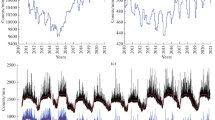Abstract
The possibility that environmental effects are associated with chromosome aberrations and various congenital pathologies has been discussed previously. Recent advances in the collection and computerization of data make studying these potential associations more feasible. The aim of this study was to investigate a possible link between the number of Down syndrome (DS) cases detected prenatally or at birth yearly in Israel over a 10-year period compared with the levels of solar and cosmic ray activity 1 year before the detection or birth of each affected child. Information about 1,108,449 births was collected for the years 1990–2000, excluding 1991, when data were unavailable. A total of 1,310 cases of DS were detected prenatally or at birth—138 in the non-Jewish community and 1,172 in the Jewish population. Solar activity indices—sunspot number and solar radio flux 2,800 MHz at 10.7 cm wavelength for 1989–1999—were compared with the number of DS cases detected. Pearson correlation coefficients (r) and their probabilities (P) were established for the percentage of DS cases in the whole population. There was a significant inverse correlation between the indices of solar activity and the number of cases of DS detected—r=−0.78, P=0.008 for sunspot number and r=−0.76, P=0.01 for solar flux. The possibility that cosmophysical factors inversely related to solar activity play a role in the pathogenesis of chromosome aberrations should be considered. We have confirmed a strong trend towards an association between the cosmic ray activity level and the incidence of DS.



Similar content being viewed by others
References
Amelino-Camelia G (2002) Relativity: special treatment. Nature 418(4):34–35
Apatity Neutron Monitory Station (1973–2001) Cosmic rays: monthly data. Apatity Neutron Monitory Station, Russian Academy of Sciences
Archer VE (1979) Anencephalus, drinking water, geomagnetism and cosmic radiation. Am J Epidemiol 109:88–97
Brooks AL, Bao S, Rithidech K, Couch LA, Braby LA (2001) Relative effectiveness of HZE iron-56 particles for the induction of cytogenetic damage in vivo. Radiat Res 155:353–359
Davidov B, Goldman B, Akstein E, Barkai G, Legum C, Dar H, Romem Y, Amiel A, Cohen H, Bach G, Appelman Z, Shohat M (1994) Prenatal testing for Down syndrome in the Jewish and non-Jewish populations in Israel. Isr J Med Sci 30:629–633
Fenig E, Mishaeli M, Kalish Y, Lishner M (2001) Pregnancy and radiation. Cancer Treat Rev 27:1–7
Halpern GJ, Stoupel EG, Barkai G, Chaki R, Legum C, Fejgin MD, Shohat M (1995) Solar activity cycle and the incidence of foetal chromosome abnormalities detected at prenatal diagnosis. Int J Biometeorol 39:59–63
Hammer GP, Zeeb H, Tveten U, Blettner M (2000) Comparing different methods of estimating cosmic radiation exposure of airline personnel. Radiat Environ Biophys 39:227–231
Kochupillai N, Verma IC, Grewal MS, Ramalingaswami V (1976) Down’s syndrome and related abnormalities in an area of high background radiation in coastal Kerala. Nature 272:60–61
Lean J, Rind D (2001) Earth’s response to a variable sun. Science 292:234–236
Merlob P, Reisner SH, Shimshoni M, Stoupel E (1989) Fetal growth in extreme periods of solar activity in the 21–22 solar cycles. J Foet Med 9:1–5
Morris JK, Alberman E, Mutton D (1998) Is there evidence of clustering in Down syndrome? Int J Epidemiol 27:495–498
Nielson J, Holm V, Haahr J (1975) Prevalence of Edward’s syndrome. Clustering and seasonal variation. Humangenetik 26:113–116
NOAA. Solar indices bulletin (monthly). National Geophysical Data Center, Boulder, Colo.
NOAA–USAF Space Environment Services Center. Weekly highlights and forecasts. Highlights of solar and geomagnetic activity (weekly). Boulder, Colo.
Seifert C, Sommer A (1986) A summertime peak of Down’s syndrome in Franklin County, Ohio. Am J Dis Child 140:822–824
Shohat M, Frimer H, Shohat-Levy V, Esmailzadeh H, Appelman Z, Ben-Neriah Z, Dar H, Orr-Urtreger A, Amiel A, Gershoni R, Manor E, Barkai G, Shalev S, Gelman-Kohen Z, Reish O, Lev D, Davidov B, Goldman B (2003) Prenatal diagnosis of Down syndrome—ten year experience in the Israeli population. Am J Med Genet 122:215–222
Sigl G (2001) Ultrahigh-energy cosmic rays: physics and astrophysics at extreme energies. Science 291:73–79
Stoll C, Alembik Y, Dott B, Roth MP (1998) Study of Down syndrome in 238,942 consecutive births. Ann Genet 41:44–51
Stolwijk AM, Jongbloet PH, Zielhuis GA, Gabreels FJ (1997) Seasonal variation in the prevalence of Down syndrome at birth: a review. J Epidemiol Community Health 51:350–353
Stoupel E, Israelevich P, Gabbay U, Abramson E, Petrauskiene J, Kalediene R, Domarkiene S, Sulkes J (2000) Correlation of two levels of space proton flux with monthly distribution of deaths from cardiovascular diseases and suicide. J Basic Clin Physiol Pharmacol 11(1):63–71
Stoupel E, Israelevich P, Petrauskiene J, Kalediene R, Abramson E, Gabbay U, Sulkes J (2002a) Cosmic rays activity and monthly number of deaths: a correlative study. J Basic Clin Physiol Pharmacol 13(1):23–32
Stoupel E, Zhemaityte D, Drungiliene S, Martinkenas A, Abramson E, Sulkes J (2002b) Klaipeda cardiovascular emergency aid services correlate with 10 cosmo-physical parameters by time of occurrence. J Clin Basic Cardiol 5:225–227
Stoupel E, Petrauskiene J, Abramson E, Kalediene R, Sulkes J (2002c) Distribution of monthly deaths, solar (SA) and geomagnetic (GMA) activity: their interrelationship in the last decade of the second millennium: the Lithuanian study 1990–1999. Biomed Pharmacother 56 [Suppl 2]:301–308
Stoupel E (2002) The equilibrium paradigm in clinical cosmobiology. J Basic Clin Physiol Pharmacol 13(3):255–261
Tcizhevskij A (1936) The terrestrial echoes of solar storm. Nauka, Moscow
Acknowledgements
The authors thank Dr Gabrielle J. Halpern for her editorial assistance and Dr Avi Orr-Urtreger for his helpful contribution.
Author information
Authors and Affiliations
Corresponding author
Rights and permissions
About this article
Cite this article
Stoupel, E.G., Frimer, H., Appelman, Z. et al. Chromosome aberration and environmental physical activity: Down syndrome and solar and cosmic ray activity, Israel, 1990–2000. Int J Biometeorol 50, 1–5 (2005). https://doi.org/10.1007/s00484-005-0274-2
Received:
Revised:
Accepted:
Published:
Issue Date:
DOI: https://doi.org/10.1007/s00484-005-0274-2




